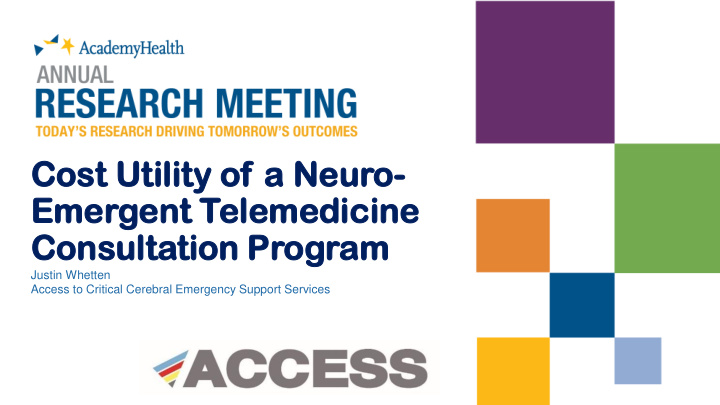



1 Co Cost st Uti tility ity of a N Neuro- Eme mergent ent Tel elem emedi edicine cine Co Consul sulta tation tion Program Justin Whetten Access to Critical Cerebral Emergency Support Services
DISCLAIMER 2 • The project described is supported by Grant Number 1C1CMS331351-01-00 from the Department of Health and Human Services, Centers for Medicare & Medicaid Services. The contents of this document are solely the responsibility of authors and do not necessarily represent the official views of the U.S. Department of Health and Human Services or any of it agencies. The research presented here was conducted by the awardee. Findings might or might not be consistent with or confirmed by the findings of the independent evaluation contractor.
Special Thanks to ACCESS Team members 3 Howard Yonas MD – PI, Mark Moffett PhD - Project Economist and Coinvestigator, Colin Semper MBA HCM CAAMA - Director, Susy Salvo-Wendt - Program Manager, Andrew Hollander PhD MBA PMP - Sr. Program Manager, Debra Banks MSN RN – Clinical Nurse Director, Deirdre Kearney MSN RN – Clinical Nurse Director, Elizabeth Muller RN CNRN – Research Nurse, Mingma Sherpa – Community Engagement, Kevin Smith PhD – Research Information Specialist, Vincent Gatlin – Program Planning Manager, Julianna Montoya – Program Coordinator, Gina Encinias – Project Accountant, Ami Montes – Research Tech, Kristen Broesder – Admin Assistant
4 Objectives • To evaluate the cost utility of Neuro-Emergent Telemedicine Stroke Consultations in the management of acute ischemic stroke from the societal perspective • Determine patient cost savings and health outcomes • Explain potential gains to rural area hospitals
Background 5 • Stroke – 5 th leading cause of death in U.S. and in New Mexico (NM – IBIS, 2014) • 80% of all strokes are Acute ischemic stroke (AIS) • Less than 2% of rural patients receive Tissue Plasminogen Activator (tPA) • 73% - New Mexicans live greater than 80 miles from a level one designated neurological center • Over 88% of patient transfers are unnecessary transfers
Neuro-Emergent Telemedicine 6 Consultation Program • Allows rural doctors to consult with a neurologist • Improve patient outcomes • Reduce unnecessary transfers • Allows rural hospitals to keep patients
7 Question • What is the cost-effectiveness of a Neuro-Emergent Telemedicine Consultation Program from the societal perspective?
Methods 8 Lifetime Markov model
Methods 9 Stroke Tunnel state
Methods 10 • Health states based on the modified Rankin scale • Minimal-to-no disability • Moderate-to-severe disability • Death • Costs • Initial and recurrent stroke treatment • Rehabilitation, long-term care, caregiver costs • Consultation • Hospital transfer • Model inputs were obtained from ACCESS supplemented by current literature
ACCESS 11 Access to Critical Cerebral Emergency Support Services • Patients admitted to rural emergency departments • May 2015 through February 2017 • All neurological and neurosurgical emergent encounters • 1300+ individuals
Transition Probabilities 12 Transition Access Control Scan < 3 hrs 19.47% 2% Scan > 3 hrs 80.53% 98% transfer 10% 85% don’t transfer 90% 15% tPA 84% 44% No tPA 17% 56%
Cost Inputs/ QALY`s 13 QALY Costs Minimal-to-no Disability 0.72 Cost of Scan $ 2,000 Moderate-to-severe Disability 0.38 Cost of Transfer $ 38,000 Death 0 Cost of mild stroke $ 14,102 Cost of severe stroke $ 18,856 Cost of Consultation $ 600 Cost of Rehabilitation $ 21,688 Cost of Long-term care $ 77,745 Cost of Caregiver $ 23
Results 14 Access Non-Access Difference ICER Total Costs $ 556,651.00 $ 611,576.00 -$54,925.00 -422500 QALY`s 6.17 6.04 0.13 Dominate • Compared with no network, patients treated in a telestroke network incurred $54,925 lower costs and gained 0.13 QALYs over a lifetime. • Transfer costs – Even when transfer costs were set at $0 there was a cost savings per patient of $5500.
15 Conclusions • Gain of 0.13 QALY • Cost savings of $54,925 per patient • $54,925,000 per 100 • Transfers dropped from 85% to 10% • tPA administration increased from under 2% to over 16% • Referring hospitals gained about 3.4 million per 100 patients that used ACCESS program
DISCLAIMER 16 • The project described is supported by Grant Number 1C1CMS331351-01-00 from the Department of Health and Human Services, Centers for Medicare & Medicaid Services. The contents of this document are solely the responsibility of authors and do not necessarily represent the official views of the U.S. Department of Health and Human Services or any of it agencies. The research presented here was conducted by the awardee. Findings might or might not be consistent with or confirmed by the findings of the independent evaluation contractor.
Recommend
More recommend